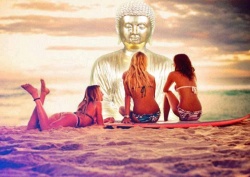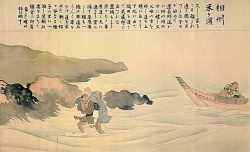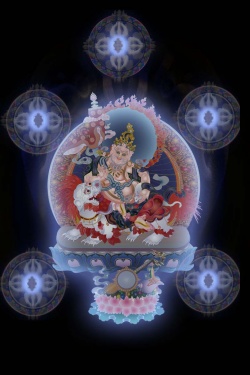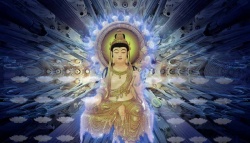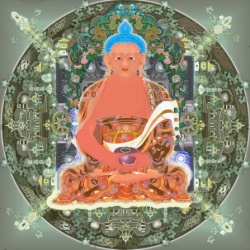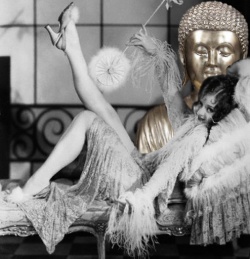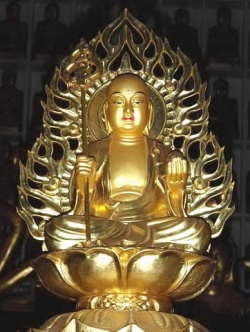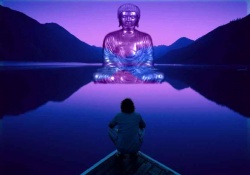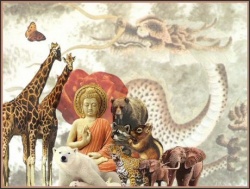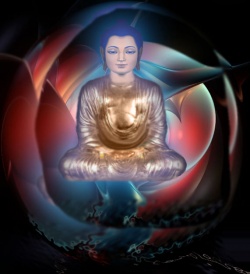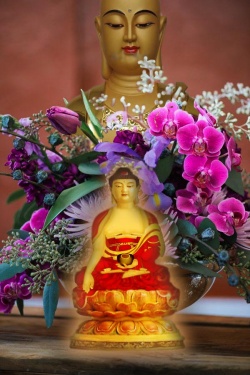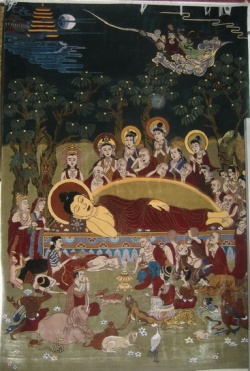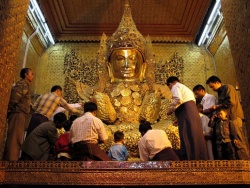8 Bodhisattvas
"All who comprise the great assemblage of Bodhisattvas are equally powerful and equally beneficial to countless beings, so that all things seem to be at their command.
Sometimes beautiful lotuses and lotus trees are caused by them to grow from the middle of the ocean, or a teardrop is transformed into an ocean. Everything in nature is at the Bodhisattva's call.
Fire can appear as water; water can appear as fire.
It is all because of the strength of the Bodhisattva's attitude, the aspiration and action.
For us this says that the practice of compassion must be given full consideration, and it must at all times be in our awareness and at all times performed."
~ 16th Karmapa Rangjung Rigpe Dorje, teaching on Compassion. (Extract of article in I K H newsletter at Ngawang Geleg's site.)
Bodhisattvas
The term bodhisattva literally means "essence of Bodhi" (budh- = awakening or, enlightenment;] hence, one on the way to Awakening.
Bodhisattvas are considered to be of various degrees of attainment or rank relating to their level (Skt. bhumi) on the 10-step path [some traditions give 13] towards buddhahood.
The highest level of these are known as the Great Bodhisattvas, and these compassionate activity-beings are 8 in number.
They can be thought of as "occupying" the intermediate directions of space, if we consider the transcendent buddhas who head the five Buddha Families as situated at the cardinal points of a mandala.
There are at least two different lists and some variations in "attributes," which in iconography means characteristic implements (or sceptres.)
Mipham (1846-1912) lists see Tashi Prayer):
Manjushri (Jampelyang) has a blue utpala flower [like Green Tara's)
Vajrapani (Chana Dorje) - vajra
Avalokiteshvara (Chenresi) - white lotus
Maitreya (Jampa) - naga tree
Kshitigarbha (Sai Nyingpo) - jewel
(Sarva)Nivarana-vishva-kambin - moon
Akashagarbha - [[blazing] sword]]
Samantabhadra (Kuntu-zangpo) - sun
Three of the Great Bodhisattvas function as Buddha-family protectors (Tib. riksum gonpo,) and are more prominent.
They are;
Avalokiteshvara,
Vajrapani and
Manjushri.
Garland of Jewels: The Eight Great Bodhisattvas by Jamgon Mipham Rinpoche, trans. Lama Yeshe Gyamtso.
Avalokiteshvara (Chenrezi)
He is the bodhisattva who emanated from the eye of Buddha Amitabha when he was moved to tears by the plight of sentient beings. In this form -- an embodiment of compassion -- he vowed not to assume buddhahood until he had liberated every single individual in all realms of existence.
He is said to have manifested in our era as Padmasambhava, and it is in reference to the legend of the manifestation of that Precious Teacher, Guru Rinpoche in the heart of a giant lotus that we say the famous 6-syllable mantra of Chenrezi: Om mani padme hum.
In the Tibetan way, it is pronounced : Om mani pehmeh hung! Inadequately translated as Hail to the jewel in the lotus, this mantra requires no special circumstances, and may be repeated at any time or place by anyone. It is an expression of compassion for all sentient (feeling) beings including oneself, and has the power to liberate anyone in any circumstance.
He appears in the Saddharma Pundarika or Lotus Sutra, along with Samantabhadra.
On the origin of Chenrezi (Avalokitesvara.)
How a Buddhist goddess evolved from Avalokiteshvara.
1,000-armed Chenresi as portrayed in a Taiwanese New Year's dance performance.
Samantabhadra
Samantabhadra's (Tib. Jangsem Kuntuzangpo) name means "all-good" or "universally worthy" after his appearance in the Gandavyuha in which he makes a set of vows accompanied by a vastly generous series of offerings. He holds a lotus with a golden wheel or the sun.
In China, as Fu-gen, he is shown seated on an elephant.
At the yearly Kamtsang (Kagyu) Monlam prayer festival that was begun by Khyabje Kalu Rinpoche years ago, the Samtantabhadra prayer called The King of Prayers is repeated 111, 000 times.
Sentient beings are as vast as space
Karma and emotion are as vast as space
Therefore may my prayers be as vast as space.
Translation of The King of Noble Aspirations. (Sanskrit: Samantabhadracarya Pranidhana; Tibetan: 'phags-pa bzang-po spyod-pa'i smon-lam-gyi rgyal-po)
Manjusri
Manjushri (Tib. Jampal yang) represents the faculty of discrimination (prajna) borne of knowledge and learning, and all 4 denominations do his practice(s.)
As an embodiment of knowledge, his ritual is recited at the beginning of the day by monks and other students.
Though in the Mipham description (at top) he holds an utpala flower, he is most usually depicted as raising a sword in his right hand (often wound with the utpala) and holding scriptures in his left. He is either seated on a throne or on an elephant.
The Sanskrit name Manjushri means "sweetly glorious."
An aspect associated with him and a great historical teacher is known as Manjughosha (the sweet-voiced.) An epithet is Vakishvara (Lord of Speech.) He is the patron bodhisattva of the Kadampa (ie.
Gelugpa) denomination.
Maitreya
Maitreya (Jampa or "Friend") is the future Buddha, often depicted seated on a chair (bhadrasana, seat of rank) holding a lotus with a stupa emerging from it. Sometimes he holds a dharmachakra or a vase containing nectar which, here, symbolizes the Buddhadharma purely preserved.
*In the China of the 1350's, still under the administration of descendants of Kublai Khan, Maitreya the Buddha of the Future, was the focus of the revolutionary sect referred to as Red Hats/Turbans. Han Lin-erh, leader of the northern band, declared himself Emperor.
Perhaps because of the familiar pose of this bodhisattva, every now and then someone in the West claims to be Maitreya, a figure that is a parallel of a Messiah or a Mahdi, but other traditional indicators have not as yet coincided.
Ksitagarbha
Kshitagarbha [Tib.: Sai.nyingpo Earth-store or Great Vow Bodhisattva is a green, seated figure with a lotus bearing a naga tree.
He is very popular in Japan where he is called Jizo, and in China where he is Di Zang Wang Pu Sa.
He is said to be the god of death, Yama himself, who vowed to work on behalf of sentient beings until all the different hells were emptied. He is known by his mendicant's staff with a khakhara (rattle) at its top -- 6 rings that jangle as he goes on his way.
To Chinese, whose name for him we transcribe as Di Zang or Ti Tsang Wang, he may be called the "god" of mercy. He is depicted with a benevolent expression, either sitting or standing.
His attributes are a Chintamani (Wish-fulfilling Jewel, often described as a pearl) and the jangling staff.
The sound of the six rings was intended as a warning to any tiny animals so that they could get out of the way and avoid being trod upon, so it is also sometimes called the alarm-staff.
In the popular depiction of Di Zang P'usa found in many Chinese Buddhist places, he wears the robe of a Northern Buddhist monk and is seated on a lotus throne.
His hands hold the precious flaming pearl with unimaginable powers.
On his head is a five-lobed crown with an image on each of the leaves of one of the five primordial buddhas.
In Japan, he is especially venerated by those who have lost children or babies, born or not.
There is usually depicted in standing posture which symbolizes the readiness of Jizo to respond immediately to those who have faith in his power of salvation.
He stands on a lotus, holding in his left hand the flaming jewel that can overcome even the most profound darkness while in his right he holds the ringed staff with which he can even force open the gates of Hell
In Ang Lee's film Crouching Tiger, Hidden Dragon Kshitagarbha, in the guise of a Ch'an master, he appears with the characteristic staff to challenge the "boy" (Zhang Ziyi) on the mezzanine of the hotel.
The public house seems to stand for one of the Buddhist hells. This symbolism is borne out by the fact that some of the weapons of the other figures -- the mace characteristic of Lord Death, for instance, -- also allude to mythological identities.
Thrangu Rinpoche tells us that Kshitagarbha was once a heavenly female known as Sacred Girl.
(Vajra-guru Very Venerable Thrangu Rinpoche, besides being tutor to HH Karmapa, is known for doing the [[Sanying Tenma] Dradrub puja]], a combined practice of Sai Nyingpo (Ksitigarbha) and Sai Lhamo Tenma (Earth Deity) involving the preparation of 1,500 treasure vases, each containing 15 different substances.)
A description of Kshitagarbha's realm in the afterlife that is situated by a flowing river, and of his cult and role in the social fabric may be found in
Liquid Life: Abortion and Buddhism in Japan by William R. LaFleur, Princeton University Press, 1994.
Akasagarbha
Akashagarbha (Namkai Nyingpo) or "Matrix of Space" is golden and may hold a jewel, though in many texts he is described as holding a lotus with a sword that radiates light. The Sadhanamala says that he is green as the dawn sky.
Vajrapani
Vajrapani (Chana Dorje ; phyag.na rdo.rje) is royal blue or blue-black, and, in peaceful form, balances the dorje upon his palm or wrathful, wields a vajra (dorje) in warning as if to throw it. In another wrathful form, he also holds a noose or fetter. In very wrathful form, he is winged.
Vajrapani (Chin: Jin Gang Shou; Jap: Kongo Shu) means "Lightning Hand," an epithet pointing to his identity with India's thunderbolt-wielding king of gods, Indra, also called Shakra (Pali: Sakka.)
This identity is borne out by his other Buddhist epithets, i.e. Vasava, Devinda, Maghava, Sahasranetra (Pali: Sahasranetta,) though in his role as a Dharma-protector, the ancient title Purindara meaning "town-wrecker" became Purinda or "town-keeper" ( R. Bannerjee.)
Indra rules the lower five of six Kama-deva-lokas and his abode is in the heaven called Trayastrimsa (Pali: Tavatimsa.)
His consort is Suja, his chariot and/or his palace is called Vijayanta (Victorious,) and his driver is called Matali.
His mount is the elephant, Airavata (Pali: Eravana.)
Vajrapani is associated with Buddha Shakyamuni and mentioned, usually by one of his other names, as the attendant who accompanied Him wherever he went. In accounts of the Buddha's life, his presence is evoked by means of the phrase,
Mighty as an Elephant or Mahasthamaprapta (Tib. Thuchenthop -- Great Strength as Elephant.)
This epithet is especially used when he is shown standing beside Amitayus (the Long-life buddha-form of Amitabha,) along with Chenrezi. In images, he is usually depicted on the left while Chenrezig is on the right of Amitayus.
(In Vietnamese, Avalokitesvara is called Quan The Am Bo Tat or Quan Am, and Mahasthanaprapta is called Dai The Chi Bo Tat.)
Bodhisattva Mahasthamaprapta was the member of the Noble Sangha who stopped a rolling boulder aimed at the Buddha while he was teaching on Emptiness at Rajgriha (Vulture's Peak.)
He therefore embodies "skillful means" or insightful technique.
Vajrapani also represents righteous wrath, an association derived from an account where, when someone behaved insolently to Buddha Shakyamuni, refusing to answer his question, he instantly appeared above his head ready to let loose a thunderbolt.
It is said that when the Tathagata subdued the gigantic naga of Udyana, he charged Vajrapani to guard the other serpents who had surrendered seeking refuge from the attack of Garuda.
He is also the enemy of the titans/demons who possessed the supreme poison halahala.
Bhutadamara "subduer of demons"
Link to 7th century bronze Vajrapani figure at Asian Arts site.
Besides being the champion of the vajra family of Buddhas, all the power of the 5 primordial buddhas are united in him.
Therefore, he is invoked to overcome interior obstacles including psychological illness, and in times of overwhelming circumstances.
In his association with tantric practices, he is sometimes called Ghuyapati or Lord of Secrets. In Japanese, he is called Kongo; in Chinese, Da Shi Zhi
He appears also in a form in which he assimilates Hayagriva and Garuda. That form of Vajrapani is believed to be especially effective against grave diseases. He is also associated with other wrathful deities depicted as winged.
An idea of a Vajrapani practice -- it is incomplete, and will certainly be inadequate without an empowerment and the transmission, ie. wang and lung.
Sarvanivarana-viskambin
Sarvanivarana-vishvakambin
Guide-to-Liberation-Obstacle-clearer (Tib. Dripa Namsal, (Chin: Chugai Zhang) is usually invoked to clear the way.
Nivarana means hindrances and refers to the 5 kleshas: desire, hatred, sloth, arrogance /suspicion, and doubt /confusion.
He attends Buddha Amoghasiddhi, the head of the Karma family considered to rule the northern direction.
He is royal blue with a moon on his lotus. In the sutras, he is with Avalokiteshvara, praising him after their fortuitous meeting in Varanasi.
Suryabaskara is a bodhisattva associated with Medicine Buddha.
A Competition
Taranatha related that once, before the beginning of a public debate between Chandragomin and Chandrakirti at Nalanda University, a procession for their ceremonial entrance had the two philosophers carrying a statue of Manjushri between them.
As they approached the gate, Chandragomin glanced at the statue which seemed to appear as Manjughosha, himself.
He spontaneously uttered a hymn of praise and onlookers say that it turned its head towards him as if to listen.
During the debate, Chandrakirti found himself unable to defeat Chandragomin's Yogacharin position.
It seemed that in the evenings, that Chandragomin was actually being coached by a stone image of Avalokiteshvara.
Then, the Madhyamakist Chandrakirti also prayed to Avalokiteshvara who appeared to him in a dream saying, "Since you are already blessed by
Manjushri, you do not need my blessings."
The debate was judged a draw.
